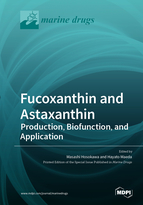Fucoxanthin and Astaxanthin—Production, Biofunction, and Application
A special issue of Marine Drugs (ISSN 1660-3397).
Deadline for manuscript submissions: closed (28 February 2022) | Viewed by 44998
Special Issue Editors
Interests: molecular nutrition of marine carotenoids; marine lipid chemistry; molecular design of functional lipids
Special Issues, Collections and Topics in MDPI journals
Interests: food function; bioactive compounds (especially lipids, polyphenol, carotenoid); functional food; metabolic disease; metabolic syndrome; gut microbiota
Special Issues, Collections and Topics in MDPI journals
Special Issue Information
Dear Colleagues,
Carotenoids are functional pigments that can be applied in the nutraceutical, cosmetic and other industrial fields. Marine carotenoids especially have a characteristic structure and exhibit unique functions that depend on that structure. Recently, the health benefits of marine carotenoids such as fucoxanthin and astaxanthin have received great attention, with many papers being published on the topic. To utilize marine carotenoids in the industrial scale, however, basic information on their biosynthesis and production is required. Food processing methods and methods to improve stability are particularly important. Further, knowledge around the bioavailability, metabolism, and signal transduction of marine carotenoids is essential to clarify their molecular mechanism and use them as nutraceuticals. The aim of this Special Issue on “Fucoxanthin and Astaxanthin—Production, Biofunction, and Application” is to present advances in the research of marine fucoxanthin and astaxanthin. We would like to invite researchers to contribute to this Special Issue by submitting original research articles and review papers.
Prof. Dr. Masashi HosokawaProf. Dr. Hayato Maeda
Guest Editors
Manuscript Submission Information
Manuscripts should be submitted online at www.mdpi.com by registering and logging in to this website. Once you are registered, click here to go to the submission form. Manuscripts can be submitted until the deadline. All submissions that pass pre-check are peer-reviewed. Accepted papers will be published continuously in the journal (as soon as accepted) and will be listed together on the special issue website. Research articles, review articles as well as short communications are invited. For planned papers, a title and short abstract (about 100 words) can be sent to the Editorial Office for announcement on this website.
Submitted manuscripts should not have been published previously, nor be under consideration for publication elsewhere (except conference proceedings papers). All manuscripts are thoroughly refereed through a single-blind peer-review process. A guide for authors and other relevant information for submission of manuscripts is available on the Instructions for Authors page. Marine Drugs is an international peer-reviewed open access monthly journal published by MDPI.
Please visit the Instructions for Authors page before submitting a manuscript. The Article Processing Charge (APC) for publication in this open access journal is 2900 CHF (Swiss Francs). Submitted papers should be well formatted and use good English. Authors may use MDPI's English editing service prior to publication or during author revisions.
Keywords
- fucoxanthin
- astaxanthin
- health benefits
- metabolism
- production
- biosynthesis
- stability
- bioavailability
- industrial application
- marine carotenoids
Related Special Issue
- Astaxanthin: A Potential Therapeutic Agent in Marine Drugs (16 articles)








